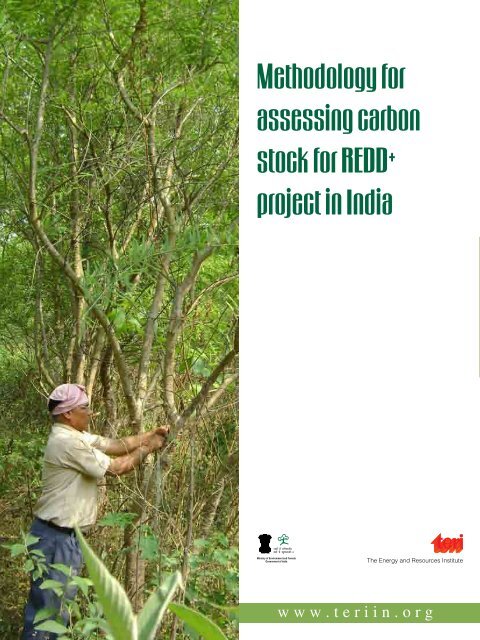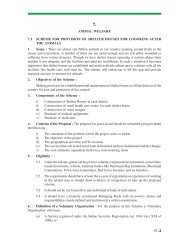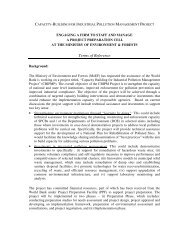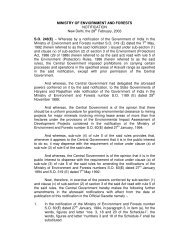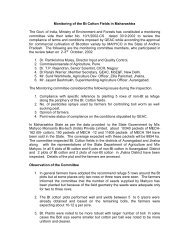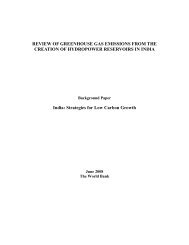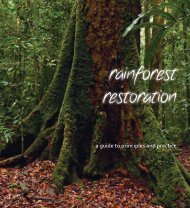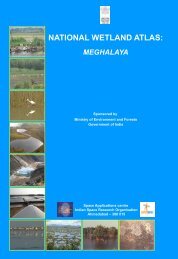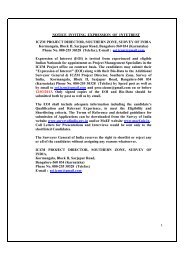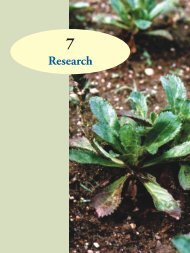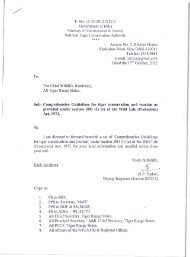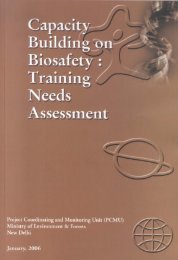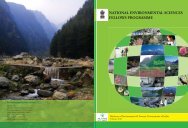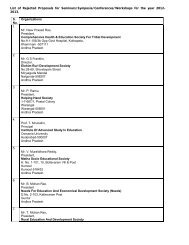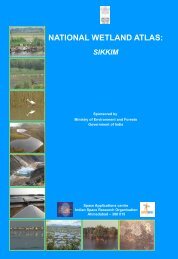Methodology for assessing carbon stock for REDD+ project in India
Methodology for assessing carbon stock for REDD+ project in India
Methodology for assessing carbon stock for REDD+ project in India
Create successful ePaper yourself
Turn your PDF publications into a flip-book with our unique Google optimized e-Paper software.
<strong>Methodology</strong> <strong>for</strong><br />
<strong>assess<strong>in</strong>g</strong> <strong>carbon</strong><br />
<strong>stock</strong> <strong>for</strong> <strong>REDD+</strong><br />
<strong>project</strong> <strong>in</strong> <strong>India</strong><br />
The Energy and Resources Institute<br />
w w w . t e r i i n . o r g
<strong>Methodology</strong> <strong>for</strong> <strong>assess<strong>in</strong>g</strong> <strong>carbon</strong><br />
<strong>stock</strong> <strong>for</strong> <strong>REDD+</strong> <strong>project</strong> <strong>in</strong> <strong>India</strong><br />
Suresh Chauhan, Fellow, TERI, New Delhi and Alok Saxena, Addl.<br />
Director, IGNFA, Dehradun<br />
Introduction<br />
<strong>India</strong> has ma<strong>in</strong>ta<strong>in</strong>ed<br />
that all countries<br />
engaged <strong>in</strong> ef<strong>for</strong>ts to<br />
ma<strong>in</strong>ta<strong>in</strong> and <strong>in</strong>crease<br />
<strong>for</strong>est <strong>carbon</strong> <strong>stock</strong>s <strong>in</strong><br />
their broader national<br />
policy framework<br />
of conservation<br />
and susta<strong>in</strong>able<br />
management of <strong>for</strong>ests<br />
should be rewarded.<br />
Reduc<strong>in</strong>g Emissions from De<strong>for</strong>estation and Forest Degradation (REDD)<br />
is an <strong>in</strong>ternational <strong>in</strong>itiative that was started at CoP-15 (Copenhagen)<br />
<strong>in</strong> 2009. Forests store a great deal of the world’s <strong>carbon</strong>; and an<br />
estimated 12–18% of global <strong>carbon</strong> dioxide (CO 2<br />
) emissions come from land<br />
use change – ma<strong>in</strong>ly de<strong>for</strong>estation and <strong>for</strong>est degradations. REDD has emerged<br />
as a central strategy <strong>in</strong> ef<strong>for</strong>ts to reduce global greenhouse gases emissions. By<br />
creat<strong>in</strong>g f<strong>in</strong>ancial <strong>in</strong>centives to reduce <strong>for</strong>est-sourced greenhouse gases, REDD<br />
<strong>project</strong>s could generate fund<strong>in</strong>g from developed to develop<strong>in</strong>g countries. This<br />
can yield significant susta<strong>in</strong>able development benefits, and may generate a new<br />
f<strong>in</strong>anc<strong>in</strong>g stream <strong>for</strong> susta<strong>in</strong>able <strong>for</strong>est management <strong>in</strong> develop<strong>in</strong>g countries<br />
such as <strong>India</strong>. <strong>REDD+</strong> goes beyond de<strong>for</strong>estation and <strong>for</strong>est degradation,<br />
and <strong>in</strong>cludes the role of conservation, susta<strong>in</strong>able management of <strong>for</strong>ests, and<br />
enhancement of <strong>for</strong>est <strong>carbon</strong> <strong>stock</strong>s (www.un-redd.org).<br />
<strong>India</strong>’s submissions to the United Nations Framework Convention on<br />
Climate Change (UNFCCC) have consistently reiterated its position to get<br />
recognition and encouragement <strong>for</strong> conservation, susta<strong>in</strong>able management of<br />
<strong>for</strong>ests, and <strong>in</strong>crease <strong>in</strong> <strong>for</strong>est cover as a potential policy approaches under<br />
<strong>REDD+</strong>. <strong>India</strong> has ma<strong>in</strong>ta<strong>in</strong>ed that all countries engaged <strong>in</strong> ef<strong>for</strong>ts to ma<strong>in</strong>ta<strong>in</strong><br />
and <strong>in</strong>crease <strong>for</strong>est <strong>carbon</strong> <strong>stock</strong>s <strong>in</strong> their broader national policy framework of<br />
conservation and susta<strong>in</strong>able management of <strong>for</strong>ests should be rewarded. The<br />
<strong>REDD+</strong> approach <strong>in</strong>corporates important benefits <strong>for</strong> improv<strong>in</strong>g livelihoods,<br />
biodiversity conservation, and food security services. Recently, <strong>India</strong> submitted<br />
the methodological guidance <strong>for</strong> a <strong>REDD+</strong> <strong>project</strong> to the UNFCCC, where<br />
it states that stratification of <strong>for</strong>est areas, Tree-outside-Forest (ToF), crown<br />
density classes, sampl<strong>in</strong>g design, precision of estimates, protocols <strong>for</strong> collect<strong>in</strong>g<br />
sample data, and models and equations used <strong>in</strong> comput<strong>in</strong>g <strong>for</strong>est <strong>carbon</strong> <strong>stock</strong>s<br />
will <strong>for</strong>m an essential part of account<strong>in</strong>g the report. All equations, growth,<br />
and biomass yield models used <strong>in</strong> the computation of <strong>for</strong>est <strong>carbon</strong> <strong>stock</strong>s<br />
will be based on published records, and freely and readily accessible to all<br />
<strong>for</strong> evaluation. Develop<strong>in</strong>g countries will have the option to choose all or any<br />
of the pools of <strong>for</strong>est <strong>carbon</strong> <strong>stock</strong>s. Indigenous peoples, local communities,<br />
civil societies and other <strong>in</strong>terested entities will be fully <strong>in</strong>volved and <strong>in</strong><strong>for</strong>med<br />
about the technological, methodological, policy, and f<strong>in</strong>ancial aspects of the<br />
Measur<strong>in</strong>g, Report<strong>in</strong>g, and Verification (MRV) processes and procedures. The<br />
objective of this paper is to exam<strong>in</strong>e the methodological issues such as scale,<br />
basel<strong>in</strong>e reference, measur<strong>in</strong>g, monitor<strong>in</strong>g, and verifications of the <strong>REDD+</strong><br />
<strong>project</strong> <strong>in</strong> context to <strong>India</strong>.<br />
3
Methodological issues<br />
It requires large number<br />
of skilled and tra<strong>in</strong>ed<br />
<strong>for</strong>estry professionals<br />
across the nation.<br />
There would be higher<br />
transaction cost due to<br />
complex bureaucratic<br />
procedures and various<br />
complex processes at a<br />
nation-level approach.<br />
Scale<br />
Scale is one of the most critical policy issues of <strong>REDD+</strong> <strong>project</strong> <strong>in</strong> the<br />
country s<strong>in</strong>ce other important parameters such as base l<strong>in</strong>e reference level,<br />
permanence, leakages, monitor<strong>in</strong>g, and <strong>in</strong>vestment all depends on it. While<br />
implement<strong>in</strong>g the <strong>REDD+</strong> <strong>project</strong>, a key question that arises is at what scale<br />
(level) should the <strong>project</strong> be implemented <strong>in</strong> the country Should it be at the<br />
national level, or subnational level (<strong>project</strong> level) or mix of both (nested or<br />
hybrid approach). There are various arguments <strong>in</strong> favour and aga<strong>in</strong>st <strong>for</strong> all<br />
these options. At the national level, favourable po<strong>in</strong>ts are it allows broad set<br />
of policies and creates country ownership. National approach acknowledges<br />
tackl<strong>in</strong>g de<strong>for</strong>estation and <strong>for</strong>est degradation more, effectively which would<br />
require policy amendments <strong>in</strong> the country.<br />
However, there are various serious constra<strong>in</strong>s while implement<strong>in</strong>g the<br />
<strong>REDD+</strong> <strong>project</strong> at the national level, such as the lack of strong federal central<br />
government systems <strong>in</strong> many develop<strong>in</strong>g and under developed countries.<br />
Management of the <strong>project</strong> at a national level would be another constra<strong>in</strong> <strong>in</strong><br />
larger countries such as <strong>India</strong>. It requires large number of skilled and tra<strong>in</strong>ed<br />
<strong>for</strong>estry professionals across the nation. There would be higher transaction cost<br />
due to complex bureaucratic procedures and various complex processes at a<br />
nation-level approach.<br />
In case of a sub-national approach, which is more suitable <strong>for</strong> a large country<br />
like <strong>India</strong>, <strong>in</strong>dividuals, communities, NGOs, civil societies, private companies,<br />
and national or local governments can implement <strong>REDD+</strong> activities <strong>in</strong> a<br />
def<strong>in</strong>ed geographical area or at a <strong>project</strong> scale. Smaller <strong>project</strong>s can help <strong>in</strong><br />
build<strong>in</strong>g capacity at the grassroots level, and spread knowledge and awareness.<br />
Smaller <strong>project</strong>s can clearly def<strong>in</strong>e <strong>project</strong> stakeholders and distribute the<br />
benefits more efficiently, and there are good possibilities of attract<strong>in</strong>g private<br />
<strong>in</strong>vestors due to simple processes and well-def<strong>in</strong>ed stakeholders.<br />
There are some negative arguments that smaller <strong>project</strong>s might not fulfil<br />
the emission reduction targets at a national or global level. Sometimes, it is<br />
difficult to monitor leakages on a small scale, and the cost of monitor<strong>in</strong>g would<br />
be relatively higher than a bigger <strong>project</strong>.<br />
A hybrid, or nested, approach tries to <strong>in</strong>clude positives from both the abovementioned<br />
approaches. The hybrid approach suggests implement<strong>in</strong>g <strong>REDD+</strong><br />
policy at the <strong>project</strong> level first and then extend<strong>in</strong>g it at a national level.<br />
Build<strong>in</strong>g the capacity of various sub-national stakeholders would be helpful <strong>in</strong><br />
implement<strong>in</strong>g the policy at national level. Credits generated could be shared<br />
between the <strong>project</strong> proponent and the central authority.<br />
There are various other options suggested by researchers from time to time.<br />
In one case, it might be possible to sub-divide one national <strong>project</strong> <strong>in</strong>to a<br />
number of small <strong>project</strong>s and then implement them with the participation of<br />
local communities and private entities. However, a more feasible scale <strong>for</strong> the<br />
country would be at the subnational level, keep<strong>in</strong>g <strong>in</strong> view the various positive<br />
po<strong>in</strong>ts of the <strong>project</strong>-level approach. Initially, some <strong>project</strong>s could be started<br />
at the <strong>project</strong> level, <strong>in</strong> order to build the capacities of various stakeholders –<br />
<strong>in</strong>clud<strong>in</strong>g the Forest staff at grass root level – and then implement it at the<br />
4
def<strong>in</strong>ed geographical area. From the <strong>India</strong>n context, village <strong>for</strong>ests, community<br />
<strong>for</strong>est resources, <strong>for</strong>est areas assigned to JFM and other areas of a similar<br />
nature may be undertaken as a unit <strong>for</strong> implement<strong>in</strong>g the <strong>REDD+</strong> <strong>project</strong>.<br />
S<strong>in</strong>ce there is no mechanism to transfer the money generated from <strong>carbon</strong><br />
trad<strong>in</strong>g to the community, it would be appropriate to have smaller <strong>project</strong><br />
areas, so that the fund would reach the community smoothly and efficiently.<br />
In <strong>India</strong>, there is an<br />
urgent need to organize<br />
capacity-build<strong>in</strong>g<br />
programmes of local<br />
communities and <strong>for</strong>est<br />
staff at the <strong>project</strong> level<br />
on methodologies <strong>for</strong><br />
<strong>assess<strong>in</strong>g</strong> <strong>carbon</strong>, <strong>in</strong><br />
order to ensure m<strong>in</strong>imal<br />
transaction cost <strong>for</strong> the<br />
preparation of <strong>REDD+</strong><br />
<strong>project</strong>s.<br />
Basel<strong>in</strong>e reference level<br />
Basel<strong>in</strong>e refers to the <strong>for</strong>est cover of an area at a certa<strong>in</strong> period aga<strong>in</strong>st which<br />
progress of the <strong>REDD+</strong> <strong>project</strong> <strong>in</strong>terventions can be measured. Basel<strong>in</strong>e<br />
reference level is another key parameter <strong>for</strong> implement<strong>in</strong>g the <strong>REDD+</strong> <strong>project</strong>,<br />
and <strong>assess<strong>in</strong>g</strong> its overall impact <strong>in</strong> terms of reduced GHGs and tradable <strong>carbon</strong><br />
credits. There are various arguments <strong>in</strong> sett<strong>in</strong>g up the basel<strong>in</strong>e reference level<br />
<strong>for</strong> the <strong>REDD+</strong> <strong>project</strong>. In this case, if a basel<strong>in</strong>e were established based on<br />
data from recent years only, it would discourage countries who have already<br />
made ef<strong>for</strong>ts <strong>for</strong> check<strong>in</strong>g the de<strong>for</strong>estation rates. Such basel<strong>in</strong>e will not<br />
yield any significant credits <strong>for</strong> them, hence would demotivate countries to<br />
participate <strong>in</strong> the process. <strong>India</strong> favours a basel<strong>in</strong>e reference level of 1990,<br />
while countries such as Brazil and Lat<strong>in</strong> America favour average of historical<br />
10 years period. Basel<strong>in</strong>e reference level should depend upon the availability<br />
of the data. <strong>India</strong> favours the 1990 basel<strong>in</strong>e due to availability of GIS, RS, and<br />
Forestry data <strong>for</strong> the entire country. <strong>India</strong> has one of the most advanced <strong>for</strong>est<br />
mapp<strong>in</strong>g programmes <strong>in</strong> the world, the Forest Survey of <strong>India</strong> (FSI) conducts<br />
a biennial cycle of <strong>for</strong>est and tree cover assessments throughout the nation. In<br />
addition, larger activities under the gamut of Susta<strong>in</strong>able Forest Management<br />
(SFM) started dur<strong>in</strong>g the 1990s with<strong>in</strong> the country.<br />
Monitor<strong>in</strong>g<br />
Regular monitor<strong>in</strong>g of the <strong>carbon</strong> <strong>stock</strong> is very important <strong>for</strong> the <strong>REDD+</strong><br />
<strong>project</strong>. However, there are various issues <strong>in</strong> monitor<strong>in</strong>g and verify<strong>in</strong>g the<br />
<strong>REDD+</strong> <strong>project</strong>; such as, there is no uni<strong>for</strong>m def<strong>in</strong><strong>in</strong>g of various terms like<br />
<strong>for</strong>ests, de<strong>for</strong>estation, and degradation, across the globe. There is a lack of<br />
uni<strong>for</strong>mly agreed density classification, which makes it difficult to monitor the<br />
progress and effectiveness of <strong>REDD+</strong> <strong>project</strong>s across the nations. There is a<br />
lack of historical data, technical skills <strong>for</strong> field measurements, <strong>carbon</strong> <strong>stock</strong><br />
calculations, and <strong>in</strong>terpretation of satellite imageries <strong>in</strong> most of the world’s<br />
develop<strong>in</strong>g and under-developed nations. Besides, monitor<strong>in</strong>g and verification<br />
requires huge expense. In <strong>India</strong>, there is an urgent need to organize capacitybuild<strong>in</strong>g<br />
programmes of local communities and <strong>for</strong>est staff at the <strong>project</strong> level<br />
on methodologies <strong>for</strong> <strong>assess<strong>in</strong>g</strong> <strong>carbon</strong>, <strong>in</strong> order to ensure m<strong>in</strong>imal transaction<br />
cost <strong>for</strong> the preparation of <strong>REDD+</strong> <strong>project</strong>s.<br />
Leakages<br />
Leakages are def<strong>in</strong>ed as changes <strong>in</strong> GHG emissions outside the <strong>project</strong><br />
boundary due to <strong>project</strong> <strong>in</strong>terventions. Leakages can reduce the impact of the<br />
<strong>project</strong> significantly, hence it should be addressed properly while implement<strong>in</strong>g<br />
the <strong>REDD+</strong> <strong>project</strong>. In <strong>India</strong>, the primary sources <strong>for</strong> leakages from the <strong>for</strong>est<br />
are fuel wood, fodder, and timber extraction. Fuel wood leakages can be<br />
reduced by deploy<strong>in</strong>g energy-efficient mechanisms, such as renewable energy<br />
5
sources – especially solar energy sources – and provid<strong>in</strong>g alternate employment<br />
to the people who were dependant on fuel wood extraction <strong>for</strong> their livelihood.<br />
Fuel wood requirements could be tackled through the <strong>in</strong>stallation of improved<br />
cook<strong>in</strong>g stoves, biogas plants, LPG, and various other means at the village<br />
level. Leakages <strong>in</strong> the <strong>for</strong>ms of fuel wood and fodder can be managed through<br />
properly implement<strong>in</strong>g the management prescriptions provided <strong>in</strong> the work<strong>in</strong>g<br />
plans and various other <strong>for</strong>estry documents, and cultivat<strong>in</strong>g nutritive grass<br />
species such as Barseem and Napier at private farms. Tree species of fodder<br />
grass such as Bhimal, Oak, Neem, and Bauh<strong>in</strong>ia should be encouraged. The<br />
leakage of timber could be managed through the proper implementation of<br />
silviculture and the management techniques provided <strong>in</strong> the work<strong>in</strong>g plans<br />
of the respective <strong>for</strong>est divisions. In addition, conservation practices and<br />
susta<strong>in</strong>able harvest<strong>in</strong>g would be encouraged.<br />
Fuel wood requirements<br />
could be tackled<br />
through the <strong>in</strong>stallation<br />
of improved cook<strong>in</strong>g<br />
stoves, biogas plants,<br />
LPG, and various other<br />
means at the village<br />
level.<br />
Carbon <strong>stock</strong> assessment<br />
<strong>India</strong> has more than 70 million hectares under <strong>for</strong>est cover and added around<br />
3 million hectares of <strong>for</strong>est cover and ToF over the last decade. <strong>India</strong> has<br />
a good set of historical data of its <strong>for</strong>est area and thus, may propose the<br />
methodology, which is based on the Remote Sens<strong>in</strong>g (RS) and Geographic<br />
In<strong>for</strong>mation System (GIS) followed by ground troth<strong>in</strong>g. The benchmark year<br />
may be considered as 1990 or 1991 depend<strong>in</strong>g upon the availability of the<br />
satellite imageries and other <strong>for</strong>estry data set. Forest cover map of 1990 and<br />
2012 (Project year) may be prepared us<strong>in</strong>g Landsat satellite data. The area<br />
would be divided <strong>in</strong>to homogenous strata based on <strong>for</strong>est types (or species<br />
composition) and canopy density through <strong>in</strong>terpretation of satellite imageries.<br />
It is proposed to classify the satellite image <strong>in</strong>to three density-classes viz.,<br />
“D 1” with tree canopy density between 10 to 40%, “D 2” with tree canopy<br />
density between 40 to 70%, and “D 3” with tree canopy density of more<br />
than 70%. Species composition, if not discernible from satellite data, can be<br />
determ<strong>in</strong>ed from ground troth<strong>in</strong>g. Field <strong>in</strong>ventory data would be collected<br />
based on appropriate sampl<strong>in</strong>g design. A comb<strong>in</strong>ation of systematic and<br />
stratified random sampl<strong>in</strong>g may be proposed based on methodology of the<br />
Forest Survey of <strong>India</strong> (FSI, 2011). In case of the <strong>project</strong> based approach,<br />
where average <strong>project</strong> size area is small (approximately 100 to 1000 ha), the<br />
entire <strong>project</strong> area may be divided <strong>in</strong>to grids of 100m x 100m (1ha). Each grid<br />
can be assigned a unique ID and classified them accord<strong>in</strong>g to the stratum it<br />
represents. Sampl<strong>in</strong>g <strong>in</strong>tensity and sample plot size would be determ<strong>in</strong>ed as<br />
per standard statistical tools. Field data such as <strong>project</strong> area, legal status of<br />
the <strong>project</strong> area, rights and concessions, topographical details, soil types and<br />
quality, site quality, status, <strong>for</strong>est types, species composition, number of stems<br />
of each species, girth, height, number of stems <strong>in</strong> each diameter class, and soil<br />
<strong>carbon</strong> data would need to be collected. Above ground <strong>carbon</strong>-<strong>stock</strong> would be<br />
calculated by tak<strong>in</strong>g the local volume equations prepared by FSI. (FSI, 1996).<br />
Below-ground <strong>carbon</strong> and <strong>carbon</strong> <strong>in</strong> the branches would be estimated us<strong>in</strong>g<br />
default values provided by IPCC Good Practices Guidel<strong>in</strong>es.<br />
Carbon <strong>stock</strong> <strong>in</strong> each grid would be determ<strong>in</strong>ed based on field data, and<br />
simultaneously, <strong>carbon</strong> <strong>stock</strong> per hectare would be estimated <strong>for</strong> each stratum.<br />
This would help <strong>in</strong> estimat<strong>in</strong>g <strong>carbon</strong> <strong>stock</strong> <strong>in</strong> the site <strong>for</strong> the benchmark<br />
year. The grids where an <strong>in</strong>crease <strong>in</strong> canopy density is observed with respect<br />
6
Carbon estimation from<br />
soil, woody litter, and<br />
decompose material<br />
would be estimated<br />
based on the present<br />
data, and it can be<br />
further compared <strong>in</strong><br />
future <strong>project</strong>s of the<br />
same area.<br />
to benchmark year will <strong>in</strong>dicate additionality due to Susta<strong>in</strong>able Forest<br />
Management (SFM) <strong>in</strong>itiatives (or other effective management practices).<br />
Similarly, a decrease <strong>in</strong> density over the years would <strong>in</strong>dicate leakage of <strong>carbon</strong><br />
from the area due to unsusta<strong>in</strong>able management practices and/or anthropogenic<br />
pressures. Carbon estimation from soil, woody litter, and decompose material<br />
would be estimated based on the present data, and it can be further compared<br />
<strong>in</strong> future <strong>project</strong>s of the same area. Socio-economic data <strong>in</strong>clud<strong>in</strong>g dependency<br />
on <strong>for</strong>est produce (firewood, small timber etc.) from the adjo<strong>in</strong><strong>in</strong>g villages would<br />
be collected through conduct<strong>in</strong>g household surveys and group discussions.<br />
Such data would help <strong>in</strong> understand<strong>in</strong>g the anthropogenic demands and<br />
further improvement of management <strong>in</strong>terventions <strong>for</strong> SFM.<br />
Remote sens<strong>in</strong>g and GIS based methodology will help <strong>in</strong> estimat<strong>in</strong>g<br />
<strong>carbon</strong> <strong>stock</strong> of the benchmark year as well as <strong>for</strong> future temporal estimation<br />
at periodic <strong>in</strong>tervals. The output generated would help <strong>in</strong> understand<strong>in</strong>g the<br />
impact of on-go<strong>in</strong>g management practices, suggest<strong>in</strong>g improved practices, and<br />
support<strong>in</strong>g decision-mak<strong>in</strong>g processes. Annual <strong>in</strong>crement data of the dom<strong>in</strong>ant<br />
species from the secondary sources (like Work<strong>in</strong>g Plan Document) can be used<br />
to ref<strong>in</strong>e the estimate, particularly <strong>in</strong> grids where there is no change <strong>in</strong> the<br />
density class over the past few years. Such data is needed as, while remote<br />
sens<strong>in</strong>g data may not show any <strong>in</strong>crease <strong>in</strong> grids where there is no change <strong>in</strong><br />
canopy density, there would certa<strong>in</strong>ly be an <strong>in</strong>crease <strong>in</strong> <strong>carbon</strong> <strong>stock</strong> because<br />
of annual <strong>in</strong>crements <strong>in</strong> the above ground woody volume of the tree.<br />
References<br />
Food and Agriculture Organization of the United Nations (FAO). 2005. Global<br />
Forest Resources Assessment, Rome, Italy<br />
Forest Survey of <strong>India</strong> (FSI). 2011. <strong>India</strong> State of Forest Survey Report, 2011,<br />
(http://www.fsi.org.<strong>in</strong>/sfr_2011.htm)<br />
Forest Survey of <strong>India</strong> (FSI). 1996). Volume equations <strong>for</strong> <strong>for</strong>ests of <strong>India</strong>, Nepal<br />
and Bhutan. M<strong>in</strong>istry of Environment and Forests, Govt. of <strong>India</strong>. pp. 249.<br />
www.un-redd.org<br />
7
For further details, contact<br />
J V Sharma<br />
Senior Fellow, Forestry and Biodiversity<br />
The Energy and Resources Institute (TERI)<br />
Darbari Seth Block, IHC Complex,<br />
Lodhi Road, New Delhi – 110 003<br />
Tel. 2468 2100 or 4150 4900, Fax 2468 2144 or<br />
2468 2145 <strong>India</strong> +91 • Delhi (0) 11<br />
E-mail jv.sharma@teri.res.<strong>in</strong><br />
Web www.teri<strong>in</strong>.org<br />
Mr Subhash Chandra, IFS<br />
DIG (Forest Policy)<br />
M<strong>in</strong>istry of Environment & Forests,<br />
Paryavaran Bhavan<br />
CGO Complex, Lodi Road,<br />
New Delhi 110 003<br />
Telefax: 011-24363974<br />
Email:subhaash.chandra@gmail.com


